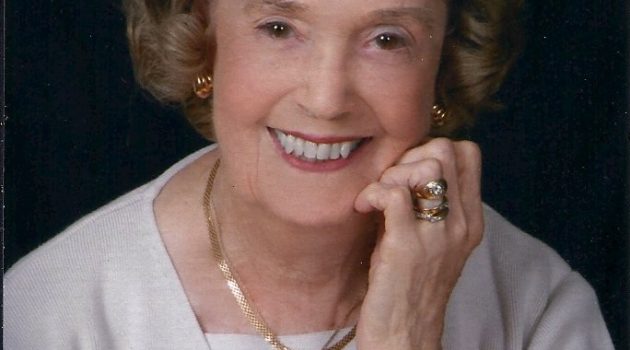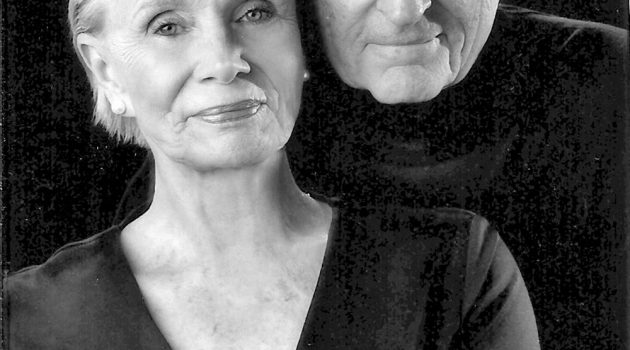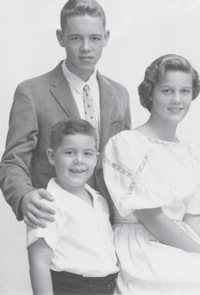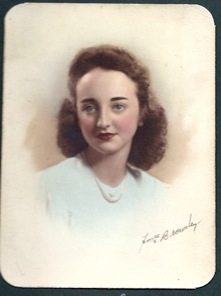The Way We Were: Betty Sterling

By Laura Jane Pittman When Betty Sterling and her husband Stu were looking to move from Memphis, TN in 1972 after Stu retired from being a Captain in the Navy, they had a wealth of familiar choices. The couple had lived in several U.S. mainland states, as well as more exotic locales such […]
The Way We Were: Alice Coughlin

By Laura Jane
Pittman
It
says a lot when someone who has experienced the metropolitan worlds of Houston
and New York City is happy to call Jacksonville home. Alice Coughlin wouldn’t dream
of living anywhere else. Even though she smilingly admits to crying for her
first two years here while she adjusted, she considers herself a true Floridian
and “absolutely loves Jacksonville.”
A
former (and occasionally current) fashion model who grew up in Houston,
Coughlin and her husband Warren moved to Jacksonville from New York City in
1958, after he purchased the “little tiny franchise” first known as Florida
Wired Music, later becoming Florida Sound Engineering Company.
The
popularity of Muzak soared during the next few decades, so the Coughlin’s
franchise didn’t stay little for long. The company eventually bought other
franchises and installed sound systems throughout the state and in such local
buildings as Independent Life, Southern Bell, and the original Gator
Bowl.
Meanwhile,
the couple was busy raising children Mark and Cyndi – who were 12 and eight at
the time of the move.
“We
first rented a house in St. Nicholas on Palmer Terrace, and the children could
walk to school at Assumption,” recalled Coughlin. “Mark would get up early in
the morning and walk down to the river to go fishing. I told him I was NOT
cleaning fish, so when he cleaned what he caught, I would cook them for
breakfast.”
From
time to time, Mark would watch Jacksonville artist John McIver painting on the
banks of the St. Johns River. And although the family loved the convenience of
St. Nicholas – there was a medical clinic close by on one corner of Atlantic,
an A&P (now the site of Curry Thomas Hardware) on the other, and a
drugstore at the site of Mudville Grille – some bulldozers in the San Jose
Forest area caught Coughlin’s eye.
“I
developed the bug for designing and building houses when we were in Houston. So
I asked around and found out they were building a new neighborhood. We went
tromping around in boots and work clothes to pick out our lot,” she smiled. “We
built on Saragossa and were the third house in the neighborhood.”
The
family sat down to dinner together every night and shared events from the day,
a tradition that both parents and children treasured. They also frequented
downtown and loved to attend fashion shows at the hotels. Daughter Cyndi would
ride the bus downtown with friends to go shopping and to the movies.
Coughlin
remembers when Epping Forest was mostly woods, and she recalls how much easier
traveling to the other side of the river became once the Buckman Bridge was
built in the early 1970s.
During
the 1970s, Coughlin served on the symphony board and also volunteered with the
American Cancer Society, whose office used to be at the Koger Center on Beach
Boulevard. She still works with the organization today.
After
their stint in San Jose Forest, the family built a house in Deerwood. On a
November 2, 1975 visit to Jacksonville, one of President Gerald R. Ford’s
stops, as memorialized in his daily diary, was the Coughlin house. Cyndi and
her husband Kent Schmidt were on hand to meet him.
Coughlin
grew tired of big houses, and the couple lived for a time at 6000 On The River
condominiums in the San Jose neighborhood, before biting the bullet once again
and building a house in Mandarin where they lived for 12 years. Nine years ago,
they built another home on Sorrento Road in order to be within walking distance
of the San Marco community.
The
greatest tragedy in Coughlin’s life was the loss of son Mark at age 48 to
cancer. Shortly after his death, she and Warren sold their company. Another sad
event occurred four years ago with Warren’s death.
Though
she misses Warren every day, Coughlin, now 84, enjoys a full life with friends
and family, including six grandchildren and six great-grandchildren (the
youngest one was born in March).
“Warren
and I had 62 amazing years together, and we were able to travel all over the
world,” she said. “We were very fortunate, and I am very blessed!”
The Way We Were: Doug Milne

Doug
Milne wears many hats — husband, father, grandfather, attorney, civic leader,
mentor, friend and local historian just to name a few.
Moving
from the Northwest in 1946 at the age of three with parents Doug and Betty and
infant sister Mary, Milne’s wide-angle view of Jacksonville’s civic character
began on the patrol boy drill field of Lackawanna Park.
“There
were not as many cars when I grew up. Sections of town were more isolated from
one another. My friends and I did not visit other sections of Jacksonville very
often. Indeed, we called Avondale Our Town.
I
didn’t realize that Greater Jacksonville was a collection of Our Towns, each
with its own unique history and culture. My patrol boy drill days introduced me
to kids from Springfield, Ribault, Wesconnett, and Arlington, and they helped
me understand that different parts of Jacksonville are like various creeks that
drain into the St. Johns. They have unique names but they all flow into the
same river.
Two
other events helped me broaden my civic outlook. I was selected as a
representative to a YMCA world youth conference when I was a 17-years-old
junior at Lee HS. This was a 10-day residential experience in Hilversom,
Holland. I lived with youth representatives from 48 different countries. It was
quite the experience as was Florida Boys State that same year.”
The
river itself was a playground for Milne and his friends, David Nussbaum,
Michael Hughes and Michael Fisher (who ran away from home every day and lived
with Doug’s family until dinner.)
“J.F.
Bryan had a ski boat that he shared. We water-skied behind it. We fished, too,
and that is a sport I still love. When we weren’t on the river, we sometimes
were in the streets. Pine Street, where I lived, was always full of activities.
One
of the activities was cork ball, a game created by Chuck Rogers, director of city
parks, and father of legendary Lee football coach, Corky Rogers. The game
required that you wrap a cork in tape and position two pennies on it. You hit
it with a broom handle and ran. A good player could make that cork dance.
Later,
during high school at Lee, I participated in Hi-Y and in more structured
athletics, baseball primarily. I was also on a Beaches baseball team that was
written up in a local newspaper as “The Boys of Summer” even though we weren’t
all that good.”
But
play was only one part of the era’s equation.
“When
I was 14, I got a Times Union paper route which consisted of morning delivery
for 138 papers. My father informed me that the route was more about the
importance of work than it was about the money. It did teach me about work. I
am forever thankful that on frigid or rainy morning, my mother would get up at
4:00 a.m. and drive me around the route. Collections were always on Friday.
The
money I did make went farther then. Hamburgers at the Avondale drugstore were
25 cents and a shake was 25 also. With two cents tax, that meant lunch was 52
cents total. At one point, too, my mom would take carloads of my friends and me
to the Edgewood movie theater where we could watch two features, a cartoon and
a newsreel, eat popcorn and a hotdog and not spend an entire dollar. Some
things have changed.”
And
some things have not. Milne’s children Doug, Joey, Mary Susan and William grew
up in the same neighborhood where their father played champion cork ball. Milne
and his wife Nora, an adoption and foster care administrator, live two blocks
from the Pine Street house where his mother still lives. After spending time at
the University of the South, Sewanee and the University of Florida law school,
Milne returned to Avondale to nourish the deep struck roots of friends, family
and community.
The Way We Were: Dorothy Harding

When Dorothy
Harding, her husband Jen (short for Jennings), and nine-year-old daughter Bette
(now Bette Loyd) first moved to Jacksonville in 1957, they were lucky enough to
settle in the Lakewood area, in part because Harding’s mother-in-law and
stepfather had a house on Rollins Avenue. And they have never left.
Harding
and Loyd now live next door to each other on twin riverfront lots at the end of
Baylor Lane. The two gracious Southern ladies recently had fun reminiscing
about their many decades in the neighborhood.
After
three short months at the Lakewood Apartments, the family lived first on Mercer
Circle, which backed up to Christopher Creek, and then on San Carlos Road.
“The
kids on Mercer Circle told me there were alligators in the creek, but Momma and
Daddy told me there certainly were not,” remembers Loyd. “One day, I heard a
bloodcurdling scream, and there was Momma standing there with a big old gator
in the yard.”
The
children would play in the woods on the other side of the creek. The woods are
now the San Jose Forest neighborhood. Loyd attended Grace Chapel Parish School
(now San Jose Episcopal Day School), and her grandparents were members at the
church. Back in those days, if women didn’t have a hat on for church, they
would pin a Kleenex on their head before going to the service.
The
Harding family spent many Sunday afternoons driving down to Mandarin. San Jose
Boulevard at that time was a two-lane road lined with big oak trees and Spanish
moss. A family friend in Switzerland (“way out in the country”) had a house
that looked like a Swiss chalet, which is still there today, and Loyd loved to
pet their goats and pick oranges from the many orange trees on the property.
Lakewood
Shopping Center was a place the family frequented. Loyd would go to Lakewood
Pharmacy every Saturday with friends to have a banana split, and for a time,
Harding worked at the Lakewood Children’s Shoppe. They also liked Clark’s
Market for meat (the current site of Mojo BBQ), dress shops French Novelty and
the Vogue (where Winn-Dixie is), the record shop – where Loyd would buy 45 rpm
singles of Top 40 hits – and Dipper Dan’s for ice cream.
In
1960, Harding’s husband acquired the Atlantic Firebrick Company, which is still
in operation. Harding worked the night shift as a switchboard operator at the
naval station when her daughter was little, and then stayed busy with volunteer
pursuits – she was at Memorial Hospital to volunteer the day it opened – and
with a longtime bridge group.
“We
called it ‘Margarita Bridge’ because we started with coffee in the morning,
played bridge, and then about 11:00 would have margaritas and lunch,” she
laughed. “It was a lot of fun, and we played together for about 20 years.”
In
1972, Harding got wind of a riverfront home for sale on Baylor Lane. She didn’t
ever imagine the couple could afford it, but she mentioned it to her husband
anyway.
“Jen
took one look around the property, heard the price, and said, ‘We’ll take it!’
without ever setting foot in the house. We paid $130,000 for it,” she
remembered.
They
subsequently acquired an additional two-acre lot next door, which Jen set up as
a putting green (laying concrete and maintaining perfect grass turf on top). He
spent many afternoons honing his golf game and using the river for driving
practice.
Loyd
now lives in the family’s original house, and Harding built on the adjacent
property about nine years ago. The two eat dinner together a couple of nights
each week, usually joined by Loyd’s two sons, and they talk on the phone every
day.
“It
feels good being next door to each other,” said Harding. “I’m so thankful
because this is all the family I have.”





